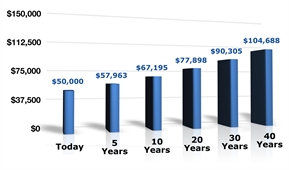You don’t want to pay any more in tax than you have to. That means taking advantage of every strategy, deduction, and credit that you’re entitled to. However, the window of opportunity for many tax-saving moves closes on December 31, so it’s important to evaluate your tax situation now, while there’s still time to affect your bottom line for the 2013 tax year.
 Timing is everything
Timing is everything
Consider any opportunities you have to defer income to 2014. For example, you may be able to defer a year-end bonus, or delay the collection of business debts, rents, and payments for services. Doing so may allow you to put off paying tax on the income until next year. If there’s a chance that you’ll be in a lower income tax bracket next year, deferring income could mean paying less tax on the income as well.
Similarly, consider ways to accelerate deductions into 2013. If you itemize deductions, you might accelerate some deductible expenses like medical expenses, qualifying interest, or state and local taxes by making payments before year-end. Or, you might consider making next year’s charitable contribution this year instead.
What if you’ll be in a higher tax bracket in 2014?
If you know that you’ll be paying taxes at a higher rate in 2014 (say, for example, that an out-of-work spouse will be reentering the workforce in January), you might take the opposite tack. Consider whether it makes sense to try to accelerate income into 2013, and to postpone deductible expenses until 2014.
Factor in the AMT
Make sure that you factor in the alternative minimum tax (AMT). If you’re subject to AMT, traditional year-end maneuvers, like deferring income and accelerating deductions, can have a negative effect. That’s because the AMT–essentially a separate federal income tax system with its own rates and rules–effectively disallows a number of itemized deductions. For example, if you’re subject to the AMT in 2013, prepaying 2014 state and local taxes won’t help your 2013 tax situation, but could hurt your 2014 bottom line.
AMT triggers
You’re more likely to be subject to the AMT if you claim a large number of personal exemptions, deductible medical expenses, state and local taxes, and miscellaneous itemized deductions. Other common triggers include home equity loan interest when proceeds aren’t used to buy, build, or improve your home, and the exercise of incentive stock options.
Landscape has changed for higher-income individuals

Most individuals will pay federal income taxes for 2013 based on the same federal income tax rate brackets (10%, 15%, 25%, 28%, 33%, and 35%) that applied for 2012. The same goes for the maximum tax rate that generally applies to long-term capital gains and qualifying dividends (for those in the 10% or 15% marginal income tax brackets, a special 0% rate generally applies; for those in the 25%, 28%, 33%, and 35% brackets, a 15% maximum rate will generally apply).
Starting this year, however, a new 39.6% federal income tax rate applies if your taxable income exceeds $400,000 ($450,000 if married filing jointly, $225,000 if married filing separately, $425,000 if filing as head of household). If your income crosses that threshold, you’ll also be subject to a new 20% maximum tax rate on long-term capital gains and qualifying dividends.
You could see a difference even if your income doesn’t reach that level. That’s because, if your adjusted gross income (AGI) is more than $250,000 ($300,000 if married filing jointly, $150,000 if married filing separately, $275,000 if filing as head of household), your personal and dependency exemptions may be phased out this year, and your itemized deductions may be limited.
Two new Medicare taxes need to be accounted for this year as well. If your wages exceed $200,000 this year ($250,000 if married filing jointly or $125,000 if married filing separately), the hospital insurance (HI) portion of the payroll tax–commonly referred to as the Medicare portion–is increased by 0.9%. Also, a new 3.8% Medicare contribution tax now generally applies to some or all of your net investment income if your modified adjusted gross income exceeds those dollar thresholds.
Required minimum distributions
Once you reach age 70½, you’re generally required to start taking required minimum distributions (RMDs) from traditional IRAs and employer-sponsored retirement plans (special rules apply if you’re still working and participating in your employer’s retirement plan). You have to make the required withdrawals by the date required–the end of the year for most individuals–or a 50% penalty tax applies.
Absent new legislation, 2013 will be the last year that you’ll be able to make qualified charitable contributions (QCDs) of up to $100,000 from an IRA directly to a qualified charity if you’re 70½ or older. Such distributions may be excluded from income and count toward satisfying any RMDs you would otherwise have to receive from your IRA in 2013.
IRAs and retirement plans a key part of planning
Make sure that you’re taking full advantage of tax-advantaged retirement savings vehicles. Traditional IRAs (assuming that you qualify to make deductible contributions) and employer-sponsored retirement plans such as 401(k) plans allow you to contribute funds pretax, reducing your 2013 taxable income. Contributions you make to a Roth IRA (assuming you meet the income requirements) or a Roth 401(k) aren’t deductible, so there’s no tax benefit for 2013, but qualified Roth distributions are completely free from federal income tax–making these retirement savings vehicles very appealing.
For 2013, you can contribute up to $17,500 to a 401(k) plan ($23,000 if you’re age 50 or older), and up to $5,500 to a traditional IRA or Roth IRA ($6,500 if age 50 or older). The window to make 2013 contributions to an employer plan typically closes at the end of the year, while you generally have until the due date of your 2013 federal income tax return to make 2013 IRA contributions.
Big changes to note
Home office deduction rules: Starting with the 2013 tax year, those who qualify to claim a home office deduction can elect to use a new simplified calculation method; under this optional method, instead of determining and allocating actual expenses, the square footage of the home office is simply multiplied by $5. There’s a cap of 300 square feet, so the maximum deduction under this method is $1,500. Not everyone can use the optional method, and there are some potential disadvantages, but for many the new simplified calculation method will be a welcome alternative.
Same-sex married couples: Same-sex couples legally married in jurisdictions that recognize same-sex marriage will be treated as married for all federal income tax purposes, even if the couple lives in a state that does not recognize same-sex marriage. If this applies to you, and you’re legally married on the last day of the year, you’ll generally have to file your federal income tax return as a married couple–either married filing jointly, or married filing separately. This affects only your federal income tax return–make sure you understand your state’s income tax filing requirements.
More health-care reform changes take effect in 2014: Beginning in 2014, you’ll generally be required to have adequate health-care coverage or face a penalty tax (a number of exceptions apply). A new premium tax credit will also be available to qualifying individuals.
Expiring provisions
A number of key provisions are scheduled to expire at the end of 2013, including:
Increased Internal Revenue Code (IRC) Section 179 expense limits and “bonus” depreciation provisions end.
The increased 100% exclusion of capital gain from the sale or exchange of qualified small business stock (provided certain requirements, including a five-year holding period, are met) will not apply to qualified small business stock issued and acquired after 2013.
The above-the-line deductions for qualified higher education expenses, and for up to $250 of out-of-pocket classroom expenses paid by education professionals, will not be available after the 2013 tax year.
If you itemize deductions, 2013 will be the last year you’ll be able to deduct state and local sales tax in lieu of state and local income tax.
Talk to a professional
When it comes to year-end tax planning, there’s always a lot to think about. A financial professional can help you evaluate your situation, keep you apprised of any legislative changes, and determine if any year-end moves make sense for you.
IMPORTANT DISCLOSURES
Altum Wealth Advisors does not provide investment, tax, or legal advice via this website. The information presented here is not specific to any individual’s personal circumstances. To the extent that this material concerns tax matters, it is not intended or written to be used, and cannot be used, by a taxpayer for the purpose of avoiding penalties that may be imposed by law. Each taxpayer should seek independent advice from a tax professional based on his or her individual circumstances. These materials are provided for general information and educational purposes based upon publicly available information from sources believed to be reliable—we cannot assure the accuracy or completeness of these materials. The information in these materials may change at any time and without notice.
CIRCULAR 230 NOTICE: To ensure compliance with requirements imposed by the IRS, this notice is to inform you that any tax advice included in this communication, including any attachments, is not intended or written to be used, and cannot be used, for the purpose of avoiding any federal tax penalty or promoting, marketing, or recommending to another party any transaction or matter.
Prepared by Broadridge Investor Communication Solutions, Inc. Copyright 2014.
Prepared for Altum Wealth Advisors, Steven Cliadakis, MBA, CWS®, Managing Director, Wealth Strategist. Chico, CA, San Francisco, CA.
 Now, more than ever, consumers are relying on the convenience of credit and debit cards to make everyday purchases, such as gas and groceries, and to make online purchases. With this convenience, however, comes the risk of having your account information compromised by a data breach.
Now, more than ever, consumers are relying on the convenience of credit and debit cards to make everyday purchases, such as gas and groceries, and to make online purchases. With this convenience, however, comes the risk of having your account information compromised by a data breach.
 As baby boomers retire, they begin to focus less on accumulating assets and more on how those assets can be converted into an ongoing stream of income. Distribution funds are one way to simplify that process.
As baby boomers retire, they begin to focus less on accumulating assets and more on how those assets can be converted into an ongoing stream of income. Distribution funds are one way to simplify that process. Timing is everything
Timing is everything
 Whether they’re snatching your purse, diving into your dumpster, stealing your mail, or hacking into your computer, they’re out to get you. Who are they? Identity thieves.
Whether they’re snatching your purse, diving into your dumpster, stealing your mail, or hacking into your computer, they’re out to get you. Who are they? Identity thieves. Your most important personal identifier is your Social Security number (SSN). Guard it carefully. Never carry your Social Security card with you unless you’ll need it. The same goes for other forms of identification (for example, health insurance cards) that display your SSN. If your state uses your SSN as your driver’s license number, request an alternate number.
Your most important personal identifier is your Social Security number (SSN). Guard it carefully. Never carry your Social Security card with you unless you’ll need it. The same goes for other forms of identification (for example, health insurance cards) that display your SSN. If your state uses your SSN as your driver’s license number, request an alternate number. One way to address the threat of rising rates is through maturity dates. Long-term bonds may pay a higher coupon rate than short-term bonds, but when rates rise, long-term bond values typically suffer more. That’s because investors may be reluctant to tie up their money for long periods if they expect a bond’s interest payments may suffer by comparison when newer bonds that pay higher rates are issued. The later a bond’s maturity date, the greater the risk that its yield eventually will be surpassed by that of newer bonds.
One way to address the threat of rising rates is through maturity dates. Long-term bonds may pay a higher coupon rate than short-term bonds, but when rates rise, long-term bond values typically suffer more. That’s because investors may be reluctant to tie up their money for long periods if they expect a bond’s interest payments may suffer by comparison when newer bonds that pay higher rates are issued. The later a bond’s maturity date, the greater the risk that its yield eventually will be surpassed by that of newer bonds.





